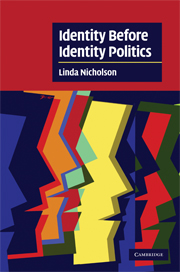Book contents
- Frontmatter
- Contents
- Acknowledgements
- Introduction
- 1 The politics of identity: race and sex before the twentieth century
- Introduction to chapters 2 and 3
- 2 Freud and the rise of the psychological self
- 3 The culture concept and social identity
- Introduction to chapters 4 and 5
- 4 Before Black Power: constructing an African American identity
- 5 Womem's identity/women's politics
- Epilogue: identity politics forty years later: assessing their value
- Index
- Cambridge Cultural Social Studies
Introduction to chapters 4 and 5
Published online by Cambridge University Press: 17 July 2009
- Frontmatter
- Contents
- Acknowledgements
- Introduction
- 1 The politics of identity: race and sex before the twentieth century
- Introduction to chapters 2 and 3
- 2 Freud and the rise of the psychological self
- 3 The culture concept and social identity
- Introduction to chapters 4 and 5
- 4 Before Black Power: constructing an African American identity
- 5 Womem's identity/women's politics
- Epilogue: identity politics forty years later: assessing their value
- Index
- Cambridge Cultural Social Studies
Summary
The discussions of the previous chapters help us to understand some of the complexity in beliefs about identity operating in the United States in the twentieth century. As the century opens, the identities of women and African Americans are more naturalized than they are for men and whites. But, during the first half of the twentieth century, new ways of thinking about identity are beginning to undermine the naturalization of racial and sexual identity for everyone, and, in the process, making more similar the identities of men and women and blacks and whites. Firstly, this new stress on the environmental causes of character led, as it did in Freud's work, to a growing appreciation for the individuality of identity. Secondly, it generated, first in the academy, and then within wider public discussions, a new concept of “culture.” This concept lent support to an increased tolerance for diversity in the practices of different social groups.
But while popular acceptance of the individualization of identity grew in general over the course of the first half of the twentieth century, the idea of tolerance was more selectively applied. It was not applied to those aspects of African American life that differentiated African Americans from European Americans. These ways of life were still mostly understood as a function of natural factors or as the problematic outcome of environmental conditions. And the practices that distinguished women from men, while more ambiguously seen as less worthy, were also not understood as “cultural” differences.
- Type
- Chapter
- Information
- Identity Before Identity Politics , pp. 92 - 93Publisher: Cambridge University PressPrint publication year: 2008

